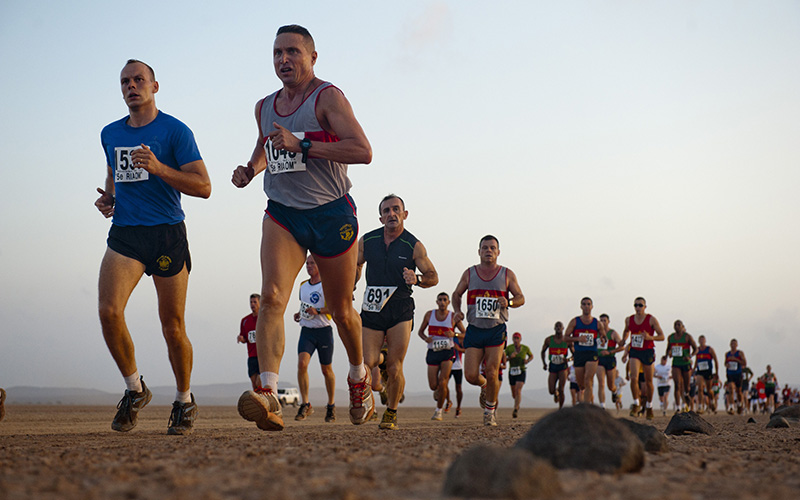Running with the Hunt, How Do Your Workouts Compare, Are You Really Fit?

Very few modern people have ever experienced what it is like to “run with the hunt.”
One of the notable exceptions is Kim Hill, Ph., an anthropologist at Arizona State University who has spent the last 30 years living with and studying the Ache hunter-gatherers of Paraguay and the Hiwi foragers of southwestern Venezuela.
His description of the amazing hunts which follow represents a rare glimpse into the activity patterns that would have been required of us all, were it not for the Agricultural Revolution.
Kim shared her story with me about a decade ago, which should be read by all contemporary athletic trainers, CrossFit enthusiasts, and by The Paleo Manifesto‘s John Durant and Breaking Muscle’s Erwan Le Corre, both good friends and colleagues who espouse ancient activity patterns for modern humans living in the western world.
“I have only spent a long time hunting with two groups, the Ache and the Hiwi.
They were very different.
The Ache hunted every day of the year if it didn’t rain. Recent GPS data I collected with them suggests that about 10 km per day is probably closer to their average distance covered during the search.
They might cover another 1–2 km per day in very rapid pursuit.
Sometimes pursuits can be extremely strenuous and last more than an hour.
Ache hunters often take an easy day after any particularly difficult day, and rainfall forces them to take a day or two a week with only an hour or two of exercise.
Basically, they do moderate days most of the time, and sometimes really hard days usually followed by a very easy day.
The difficulty of the terrain is really what killed me (ducking under low branches and vines about once every 20 seconds all day long, climbing over fallen trees, moving through tangled thorns, etc.).
I was often drenched in sweat within an hour of leaving camp and usually didn’t return for 7–9 hours with not more than 30 minutes of rest during the day.
The Ache seemed to have an easier time because they “walk better” in the forest than me (meaning the vines and branches don’t bother them as much).
The really hard days when they literally ran me into the ground were long-distance pursuits of peccary herds when the Ache hunters move at a fast trot through thick forest for about 2 hours before they catch up with the herd None of our other grad students could ever keep up with these hunts, and I only kept up because I was in very good shape back in the 1980s when I did this.
The Hiwi on the other hand only hunted about 2–3 days a week and often told me they wouldn’t go out on a particular day because they were “tired.”
They would stay home and work on tools, etc.
Their travel was not as strenuous as among the Ache (they often canoed to the hunt site), and their pursuits were usually shorter. But the Hiwi sometimes did amazing long-distance walks that would have hurt the Ache.
They would walk to visit another village maybe 80–100 km away and then stay for only an hour or two before returning.
This often included walking all night long as well as during the day.
When I hunted with Machiguenga, Yora, Yanomamo Indians in the 1980s, my focal man days were much much easier than with the Ache. And virtually all these groups take an easy day after a particularly difficult one.
By the way, the Ache do converse and even sing during some of their searches, but long-distance peccary pursuits are too difficult for any talking.
Basically, men talk to each other until the speed gets up around 3km/hour which is a very tough pace in a thick jungle.
Normal search is more like about 1.5 km/hour, a pretty leisurely pace.
Monkey hunts can also be very strenuous because they consist of bursts of sprints every 20–30 seconds (as the monkeys are flushed and flee to new cover), over a period of an hour or two without a rest.
This feels a lot like doing a very long session of wind sprints.
Both my graduate students Rob Walker and Richard Bribiescas of Harvard were very impressed by Ache’s performance on the step test.
Many of the guys in their mid-30s to mid-50s showed great aerobic conditioning compared to Americans of that age. (V02 max/kg body weight is very good.)
While hunter-gatherers are generally in good physical condition if they haven’t yet been exposed to modern diseases and diets that come soon after permanent outside contact, I would not want to exaggerate their abilities.
They are what you would expect if you took a genetic cross-section of humans and put them in lifetime physical training at moderate to hard levels.
Most hunting is search time not pursuit, thus a good deal of aerobic long-distance travel is often involved (over rough terrain and carrying loads if the hunt is successful).
I used to train for marathons as a grad student and could run at a 6:00 per mile pace for 10 miles, but the Ache would run me into the ground following peccary tracks through the dense bush for a couple of hours.
I did the 100 yd in 10.2 in high school (I was a fast pass catcher on my football team), and some Ache men can sprint as fast as me.”
Cordially,
Loren Cordain, Ph.D., Professor Emeritus